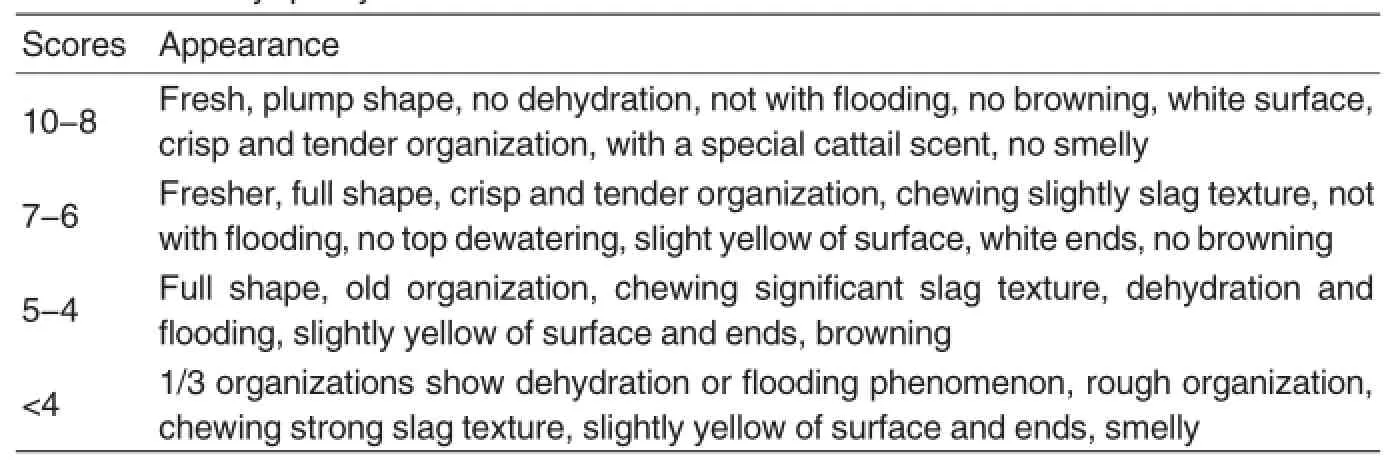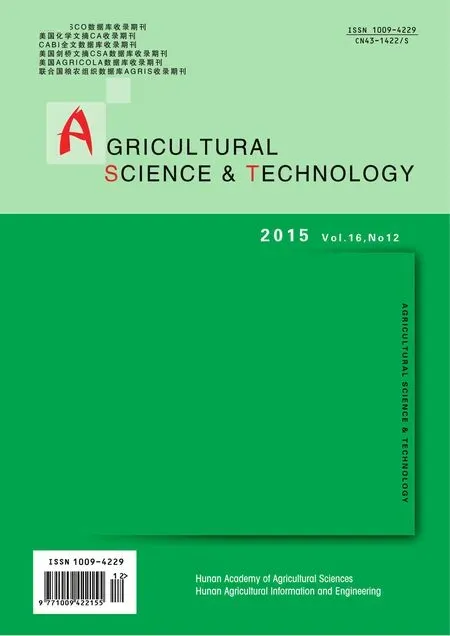Effect of Storage Temperature on the Quality of Fresh-cut Cattail
2015-11-08HeshengHUANGHaipingWANGPianPianZHANG
Hesheng HUANG,Haiping WANG,2,PianPian ZHANG
1.Jiangsu Food&Pharmaceutical Science College,Huaian 223003,Jiangsu,China;
2.Jiangsu Food Processing Research and Development Center,Huaian 223003,Jiangsu,China
Effect of Storage Temperature on the Quality of Fresh-cut Cattail
Hesheng HUANG1,Haiping WANG1,2,PianPian ZHANG1
1.Jiangsu Food&Pharmaceutical Science College,Huaian 223003,Jiangsu,China;
2.Jiangsu Food Processing Research and Development Center,Huaian 223003,Jiangsu,China
Fresh-cut cattail was extremely not resistant to store at room temperature. In the first day,it began to etiolate and rot,the fiber content increased,but the vitamin C content and reducing sugar content decreased.The aerobic bacterial count increased,the weight loss rate sharply increased,and the sensory quality and food value were gradually lost.Low temperature storage could decrease the loss of vitamin C and reducing sugar of fresh-cut cattail,reduce the weight loss rate and delay the increase of fiber content,maintain the water and nutrient of fresh-cut cattail,and the storage effect of 0℃ was better than 4℃.
Fresh-cut cattail;Preservation;Storage temperature;Quality
C attail is a kind of typhaceae plant,which is far smaller than Zizania latifolia and has tender pseudostem.The length is about 20cm,and the width is 0.5-1.0 cm.It likes to grow in shallow water and often grow near the river bank,limes marginis,pond and marsh of Yangtze river delta[1].The cattail is extremely rich in nutrient,which per 100 g of immature stem contains 1.2 g of protein,0.1 g of fat,2 g of carbohydrate,4 g of dietary fiber,6mg of vitamin C,53 mg of calcium,24 mg of phosphorus,also contains vitamin B1,vitamin B2,vitamin E,carotene and other 18 kinds of amino acids.Fresh-cut fruits and vegetables refers to an instant or practical novel processed goods that the fresh fruits and vegetables processed by a series of material selection,cleaning,sorting,segmentation,refreshment and packaging,which could keeps the product in fresh state[2].The characteristics of fresh-cut cattail are clean,fresh,easy and high edible rate,so its production and consumption will enter a rapid development stage.But peeling,segmentation and other manufacturing procedures do mechanical damage to the fruits and vegetables tissues,induce brown stain,and then cause the change of color,taste and quality.So the processing and storage technology of fresh-cut fruits and vegetables that keep the original quality and extend preservation period is a key issue.
Low temperature storage is an effective means for preservation and freshness of vegetables[3].The respi ration intensity and microbial propagation speed of stored vegetables were closely related to storage temperature. The metabolic rate of vegetables significantly reduced at low temperature in the procedure of processing,storage and sales.The decomposition of nutrient was also delayed,meanwhile the growth rate of microorganisms became slow at low temperature,which could further avoid the damage of microorganisms and prolong the storage period of vegetable products.On the contrary,in higher temperature,the total bacterial count increased,the respiratory metabolism rate was faster,the more loss of various nutrient and the storage period of vegetables was shorter.Low temperature was in favor of storage of fruits and vegetables,but too low temperature would cause cold damage phenomenon.The resistant to low temperature of different or the same fruits and vegetables were different before and after cutting. Therefore,the choice of appropriate temperature was a key factor for the storage of fruits and vegetables and their products.This study aimed to explore the best storage temperature of fresh-cut cattail,so as to provide a theoretical basis for preservation technology of fresh-cut cattail.
Materials and Methods
Materials
Cattail was collected from Tianfei Gong cattail production base in Huai'an City,Jiangsu Province.
Reagents and instruments
Reagents
All reagents were analytical grade.
lnstruments
The instruments used in this study showed in Table 1.
Test Methods
Materials handling
Test materials were the same maturity and size,and no pests.Cattail was cut into 4-5 cm of small pieces by sharp knife and avoid damage to the cattail in the cutting process.Flushed with water for 15s,dried naturally,and packed with polyethylene plastic bags. Stored at(0±1)℃,(4±1)℃and room temperature(average temperature was 28℃).Technological process was as follows:cattail selection and handling→ cleaning→ draining→ cutting→packing→storage[4].
Determination of the fiber content
Determined by Anthrone method[5].
Determination of the Vitamin C content
Determined by 2,6-dichloro indophenol titration method[6].
Determination of the reducing sugar content
Determined by direct titration method[7].
Determination of the weight loss ratio
Determined by weighing method.
Determination of the total bacterial count
Determined by the reference method GB4789.2—2010"total bacterial count determination".
Sensory index evaluation
20 people were randomly selected to score the sensory quality of fresh-cut cattail[8],and the scoring criteria was showed in Table 2.The results were average score.
Data statistics and analysis
Alltests were repeated three times,and the results showed by x±S. The test data were processed by SPSS16.0 software,then did ANOVA and significance analysis.
Results and Analysis
Effect of storage temperature on the fiber content of fresh-cut cattail
The fiber content of the samples increased with the extension of storage time(Fig.1).The fiber content increased fastest when the samples stored at room temperature,increased more slowly when the samples stored at 4℃,and increased slowest when the samples stored at 0℃,which was almost in the steady state.The increase of fiber content had a great impact on the taste of fruits and vegetables.The fiber content of the samples sharply increased in the late period of storage time(10-13 d),the loss rate of nutriment was higher and the food value lost.
Effect of storage temperature on the vitamin C content of fresh-cut cattail
With the extension ofstorage time,the vitamin C content of fresh-cut cattail dropped gradually (Fig.2).After stored for 1d,the vitamin C content of three treatmentgroups decreased from the initial 99 μg/g to 97,95,90 μg/g.In the whole storage period,the vitamin C content of fresh-cut cattail decreased fast in the first 4 days when the samples stored at room temperature,which decreased 28.9%.The vitamin C content of the low temperature treatments decreased slowly in the whole storage period,and two low temperature treatments had significant difference after stored for 4 days. When stored at 0℃,the change of vitamin C content was not significant in the first 4 days,and decreased obviously after 4 days.Comprehensive the above analysis results,the vitamin C content decreased sharply when the fresh-cut cattail stored at room temperature,which decreased relatively less under cold storage conditions. The storage effect of 0℃was better than 4℃,which was better to keep the nutrient content of cattail.

Table 1 Instruments

Table 2 Sensory quality evaluation and scores of fresh-cut cattail
Effect of storage temperature on the reducing sugar content of freshcut cattail
The reducing sugar content decreased sharply when the fresh-cut cattail stored at room temperature,which reduced about 50%after stored for 4 days(Fig.3).When stored at low temperature,the reducing sugar content had a certain rise initially,and then showed a declining trend,probably because the active respiration action prompted the organic matter to degrade into sugar and then further degraded.The reducing sugar content of fresh-cut cattail stored at low temperature was significantly higher than the room temperature treatment in the whole storage period.It indicated that low temperature was in favor of maintain the reducing sugar in cattail.To the end of the storage period,the reducing sugar of fresh-cut cattail stored at 0℃ had no significant with that stored at 4℃.
Effect of storage temperature on weight loss ratio of fresh-cut cattail
With the extension ofstorage time,the weight loss ratio of fresh-cut cattail increased gradually in the whole storage period(Fig.4).The weight loss ratio of low temperature storage treatments was very small,which had no significant difference with the initial storage period.But the change of weight loss ratio of room temperature storage treatments was extremely significant,which indicated that low temperature storage was in favor of maintain the nutriment and moisture of fresh-cut cattail.Comprehensive the above analysis results,the change of weight loss ratio of fresh-cut cattail was small at low temperature,and the storage effect of 0℃was better than 4℃.
Effect of storage temperature on the total bacterial count of fresh-cut cattail
With the extension ofstorage time,the total bacterial count of freshcut cattail showed a rising trend,and the aerobic bacterial count of fresh-cut cattail stored at room temperature was higher than that stored at low temperature(Fig.5).The bacterial count decreased when the fresh-cutcattail stored at low temperature for the first 4 days, maybe because somemesophilic microorganism died at low temperatures.After stored for 4 days,with lower storage temperature and longer storage period,the total bacterial count increased,possibly because 0℃ had damage to fresh-cut cattail,and caused the total bacterial count increased dramatically in the late storage period.Therefore,within a certain temperature range,reducing storage temperature could effectively reduce the surface microorganisms of freshcut cattail.
Effect of storage temperature on sensory quality of fresh-cut cattail
Fresh-cut cattail rapidly became etiolation at room temperature(Table 3).After stored for 1d,individual cattail had etiolation sign.After stored for 2 days,most of cattail had etiolation and both ends slightly browning.After stored for 4 days,all cattail had etiolation and browning.In the end of storage period, cattail was seriously mildew and produced odor.Cattail stored at 4℃ had no etiolation phenomenon within 7 days,and both ends were only slightly browning.After stored for 10 days,most of fresh-cut cattail became etiolation and both cuts browning.Some cattail stored at 0℃had slightly etiolation and both cuts had slightly browning after stored for 13 days.It indicated that low temperature storage of fresh-cut cattail could potently inhibit etiolation phenomenon. In addition,the fresh-cut cattail stored at low temperature for 7 days appeared tissue softening and dehydration.The rot degree of fresh-cut cattail stored at 0℃ was lower than that stored at 4℃,which indicated that the storage effect of 0℃was better than 4℃.

Table 3 Effect of storage temperature on sensory quality of fresh-cut cattail
Discussion
Fresh-cut cattail was extremely not resistant to store at room temperature,which generated etiolation after stored for 1d and the content of fiber,vitamin C and reducing sugar continuously lost with the extension of storage period.The total bacterial count increased gradually,and then generated etiolation,mildew,rot and other adverse sensory states,the fresh-cut cattail lost its nutritional value gradually.
Low temperature storage could effectively reduce the loss of vitamin C and reducing sugar content,reduce weight loss rate,delay the increase of fiber content,which help to keep the nutrient of fresh-cut cattail,delay etiolation,mildew and rot phenomenon,and maintain sensory quality of freshcut cattail.The storage effect of 0℃was better than 4℃.Low temperature could effectively maintain sensory and physicochemical quality of fresh-cutcattail,therefore the management of the cold chain system should be strengthen in the actual production.
[1]DONG DS(董道顺).Tianxiadiyi shoots-"Tianfei Gong"cattail[J].Cooking Knowledge(烹调知识),2004(1):20-21.
[2]MAO LC(矛林春),FANG XH(方雪花). Current conditions and developing tendency of fresh-cut vegetable processing key technology and its preservation techniques(鲜切菜加工关键工艺及其保鲜技术应用现状与发展趋势)[M].Beijing:Higher Education Press(北京:高等教育出版社),1957:15-18.
[3]ZHOU YH(周运华).Study of cattail thermal processing and storage temperature conditions(蒲菜的热加工及其贮藏温度条件研究)[D].Wuxi:Jiangnan University(无锡:江南大学),2004.
[4]TU K(屠康),WU J(武杰).Cattail processing-aquatic vegetable processing technology and formula(蒲菜加工-水生蔬菜加工工艺与配方)[M].Beijing:China Light Industry Press(北京:中国轻工业出版社),1994.
[5]TAN HG(谭海刚),MEI YJ(梅英杰),GUAN FM(关凤梅),et al.Determination of trehalose content in yeast by anthrone-sulfuric acid method(蒽酮-硫酸法测定酵母中海藻糖的含量)[J].Modern Food Science and Technology(现代食品科技),2006(1):125-126,128.
[6]DONG J(董静),YANG YZ(杨用钊),ZHOU ML(周美玲).Research on production technology of cattail juice beverage(蒲菜汁饮料生产工艺研究)[J]. Journal of Anhui Agricultural Sciences(安徽农业科学),2011,39(19):11947-11949.
[7]Dalian Institute of Light Industry(大连轻工业学院),South China University of Technology(华南理工大学),Zhengzhou Institute of Technology(郑州工业学院),et al.Food Analysis(食品分析)[M].Beijing:China Light Industry Press(北京:中国轻工业出版社),1994:286-289.
[8]ZHANG YF(张艳芬).Study on shepherd’s purse quality and physiological characteristics changes in low temperature storage period(低温贮藏期间荠菜品质和生理特性变化研究)[D].Nanjing: Nanjing Agricultural College(南京:南京农业大学),2007.
Responsible editor:Lin FANG
Responsible proofreader:Xiaoyan WU
Supported by Students Practice Innovation Projects in Jiangsu Province(2012JSSPITP3590).
*Corresponding author.E-mail:wanghaiping129@163.com.
Received:September 10,2015 Accepted:November 2,2015
猜你喜欢
杂志排行
Agricultural Science & Technology的其它文章
- Study on Engineering Characteristics and Application of Sticky Rice
- Periodical Development Trend of Vertical Greening
- Advances in Microbial Remediation on the Application of Heavy Metal Pollution in Agricultural Water Resources
- Analysis on Status quo and Future Development of Fruit and Vegetable Protreatment
- Effect of Three Treatment Measures on Harmless Seedling Raising of Pinus sylvestris var. mongolica Litv.
- Discussions and Recommendations for Supervision of Vegetable Quality and Safety in Miyun County
